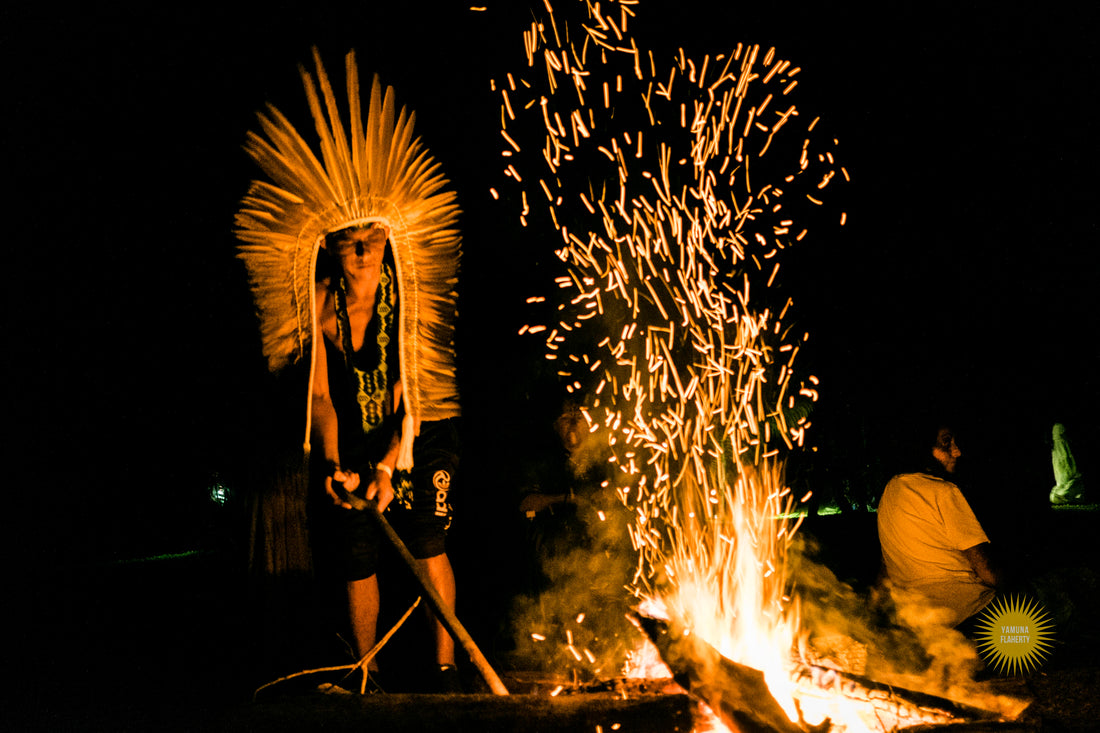Holy Ashes by Alan Seo MS
Ashes of the Sacred Rapé
One of the two indispensable ingredients of Sacred Rapé is ash and with it probably the most mysterious and least understood. It is the fire element added to the earth, it is what gives strength and lifts it up. All the Shamanic Rapés we know and love use it. Only the green Awiry of the Apurinã, the Nunu of the Matses and the old-fashioned snuff do not use ash.
The ash acts as an activator giving strength to the medicine, many of the sacred medicines and indigenous stimulants used around the world make use of this principle. The inhabitants of the Andes Mountains who chew coca leaves, the Indians (from India) who chew Pan, the betel nut and its leaf, the tribes who use Yopo snuff, all use the same technique of using their favorite plants in combination. with a base activator. It can be in the form of lime taken from crushed husks, bicarbonate, ash prepared from a variety and other sources. The closest to Rapé is Yopo made from Anadenanthera seeds which is used with some form of natural lime or specially prepared ash.
When wood is burned, the cellulose burns and turns into the white ash that we see, but most of the salts, alkaloids and other particles survive the fire and remain present in the ash in different proportions, these provide some of the product's beneficial and healing qualities. .
On a more subtle and energetic level, ash brings the fire element to the medicine, tobacco represents the earth element, smoking tobacco has a very grounding effect, we notice this when using tobacco after a medicine circle or just when someone you are stressed, it makes you ground. When using traditional ashless snuff, you can notice a very clear difference with shamanic snuff, where pure snuff is more terrifying, sacred snuff is more uplifting and takes you to another level of perception.
The fire element is represented and introduced in the medicine by the ashes that have been purified and transformed into fire, we can also say that it is the activation principle of the ashes, as we mentioned before, that changes the way our body receives them, these are different ways of explaining the same thing, one more western and the other more mystical and indigenous.
The texture of the wood gives ash consistency, so most types of wood used for Rapé ash have a narrow grain, being very hard and dense. Trees with softer woods do not produce good ash, they do not give strength to the medicine and Rapé spoils more easily, there are some exceptions, but it is a general rule, for example certain types of vines can be used to make ash, although not Let's see a lot because, in general, they have a low potency.
The most common ash used for Rapé is Tsunu, the classic ash of the Yawanawá, other commonly used ash are Murici, Pau Pereira, Parica, Cacau, Cumaru, Mulateiro and Canela de Velho, some rarer are Sapota, Balsamo and Emburana and there are others.
The information circulates on the internet that Tsunu is Pau Pereira, this is not correct and saying which tree is Pau Pereira is complex because it depends on where in Brazil you go which tree they call Pau Pereira. Most of the names used to identify these species are local folk names and in different regions of Brazil they use the same names for a variety of plants. Nobody knows the scientific names and they are almost impossible to find except for some more commonly known types like Cumaru which are used for lumbar even locally and from tribe to tribe there are different trees identified with the same names Tsunu is An example.

Most of the trees that I tried to identify using Google, proved to be wrong after checking with people inside. Traditionally, hapé makers burned only the husk of most varieties. Nowadays with the expansion of snuff consumption they generally burn the bark and wood together to increase the yield. Apparently the bark contains most of the properties, we can see that from many medicinal trees teas and other preparations are made from the bark, almost never from the wood, as well as the ashes. Unfortunately not everyone burns the correct wood, there are always unethical people or people without the proper knowledge, so it's always good to know where your medicine comes from.
The art of Ashes
Burning good ashes is an art that not everyone has mastered. You have to find the right type of tree for the ash you want, and then you have to burn it very hot to get a nice white ash. It sounds simple, but it's still an art. The ash should not get wet, so it should be kept dry before sunset or burning overnight so it doesn't get spoiled by night dew. Medicine can go bad faster when using the wrong ash, it can excessively clog your nose, or simply not have the desired effect.
When asking another friend and connoisseur of the forest about the ash, he told me the following.
“The ash is what cleans the nose, releases the mucus; tobacco by itself does not clean. Tobacco is antibacterial; ash is antiseptic, anti-inflammatory, it's what heals. It's a long, never-ending study after seventeen years of working with the drugs I still learn every day. When we go on a diet with medicine, I say the following: Rapé makes you take root and then takes you up”.
This last observation is very interesting and deserves to be elaborated on. The first few times you use Rapé, it can lower your blood pressure, make you lie down, even make you feel sick, but then you learn to maintain firmness and concentration, it gives you roots, it helps you to be more grounded. Once you take root, you can fly away!
Ashes around the world
In Ayurvedic medicine there is an extensive science, almost a form of alchemy related to the manufacture and application of medicinal ash, the so-called Bhasmas. They make ash out of the widest variety of substances, from plants, but also from minerals and certain metals. Each substance burned and transformed by fire has its own properties and with it its own use. Bhasmas are very powerful medicines used in “normal” medicines, but they have a special place in Rasayana, the science of rejuvenation. This elusive practice, even in Ayurveda, is almost lost today.
And just to mention that, Ayurveda also has the practice of Nasya, which is the use of medicinal snuff that is gently blown into the nasal passages for a variety of ailments, but that's another story.
The Sadhus, naked or scantily clad ascetics of India, make extensive use of sacred ashes. They cover their bodies with the ashes of their sacred fires, charged with the energy of their mantras and meditations. It has mystical but also practical uses, such as protection from insects. To grow their dreadlocks, sometimes meters in length, they also use special ash, again they burn specific plants that help strengthen the roots and strands of their hair and accelerate their growth.
The ash used with coca leaves in Bolivia is made from quinoa, plantains and other plants.
In West Africa they make their traditional soap out of ash. Again, they burn a certain mixture of plant materials and mix these ash with oils to create a reaction that turns the oil into soap. This soap is known to be very good for the skin, but it is also used in their religious practices for energetic cleansing.
Alchemy
Transforming materials through fire is the essence of Alchemy, it can range from a simple fire to make an ash suitable for Rapé to the ancient Ayurvedic art of making rejuvenating Bhasmas and even far beyond when we get into the ancient art of true alchemical transformation, but this is another story. Fire transforms and has the power to purify everything it touches. In the Ayurvedic art of doing Bhasmas which is the function of fire, purifying these elements and making them suitable for consumption and increasing or activating their healing power.
In the production of Rumã, as the Yawanawá call Rapé, the intention and the state of mind are essential, everything that the person thinks and desires while making the medicine is transferred and stored in this medium. Therefore, it is important that the people who produce the medicine do so with pure intentions, a positive attitude, a good heart and a certain level of spiritual evolution. All our Rapézeiros, Rapé artisans, are people totally dedicated to their traditions, Txais (brothers) who are guided on their spiritual path by these very medicines and

